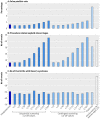Comparison of different strategies in prenatal screening for Down's syndrome: cost effectiveness analysis of computer simulation
- PMID: 19218323
- PMCID: PMC2645848
- DOI: 10.1136/bmj.b138
Comparison of different strategies in prenatal screening for Down's syndrome: cost effectiveness analysis of computer simulation
Abstract
Objectives: To assess and compare the cost effectiveness of three different strategies for prenatal screening for Down's syndrome (integrated test, sequential screening, and contingent screenings) and to determine the most useful cut-off values for risk.
Design: Computer simulations to study integrated, sequential, and contingent screening strategies with various cut-offs leading to 19 potential screening algorithms.
Data sources: The computer simulation was populated with data from the Serum Urine and Ultrasound Screening Study (SURUSS), real unit costs for healthcare interventions, and a population of 110 948 pregnancies from the province of Québec for the year 2001.
Main outcome measures: Cost effectiveness ratios, incremental cost effectiveness ratios, and screening options' outcomes.
Results: The contingent screening strategy dominated all other screening options: it had the best cost effectiveness ratio ($C26,833 per case of Down's syndrome) with fewer procedure related euploid miscarriages and unnecessary terminations (respectively, 6 and 16 per 100,000 pregnancies). It also outperformed serum screening at the second trimester. In terms of the incremental cost effectiveness ratio, contingent screening was still dominant: compared with screening based on maternal age alone, the savings were $C30,963 per additional birth with Down's syndrome averted. Contingent screening was the only screening strategy that offered early reassurance to the majority of women (77.81%) in first trimester and minimised costs by limiting retesting during the second trimester (21.05%). For the contingent and sequential screening strategies, the choice of cut-off value for risk in the first trimester test significantly affected the cost effectiveness ratios (respectively, from $C26,833 to $C37,260 and from $C35,215 to $C45,314 per case of Down's syndrome), the number of procedure related euploid miscarriages (from 6 to 46 and from 6 to 45 per 100,000 pregnancies), and the number of unnecessary terminations (from 16 to 26 and from 16 to 25 per 100,000 pregnancies).
Conclusions: Contingent screening, with a first trimester cut-off value for high risk of 1 in 9, is the preferred option for prenatal screening of women for pregnancies affected by Down's syndrome.
Conflict of interest statement
Competing interests: None declared.
Figures



Comment in
-
Prenatal screening for Down's syndrome.BMJ. 2009 Feb 13;338:b140. doi: 10.1136/bmj.b140. BMJ. 2009. PMID: 19218324 No abstract available.
References
-
- Wald NJ, Watt HC, Hackshaw AK. Integrated screening for Down’s syndrome on the basis of tests performed during the first and second trimesters. N Engl J Med 1999;341:461-7. - PubMed
-
- Wapner R, Thom E, Simpson JL, Pergament E, Silver R, Filkins K, et al. First-trimester screening for trisomies 21 and 18. N Engl J Med 2003;349:1405-13. - PubMed
-
- Roizen NJ, Patterson D. Down’s syndrome. Lancet 2003;361:1281-9. - PubMed
-
- Resta RG. Changing demographics of advanced maternal age (AMA) and the impact on the predicted incidence of Down syndrome in the United States: implications for prenatal screening and genetic counseling. Am J Med Genet A 2005;133:31-6. - PubMed
-
- Wyatt P. Integrated, sequential, and contingent screening for Down syndrome—local needs should drive methodology. Prenat Diagn 2007;27:186-7. - PubMed
Publication types
MeSH terms
LinkOut - more resources
Full Text Sources
Medical
